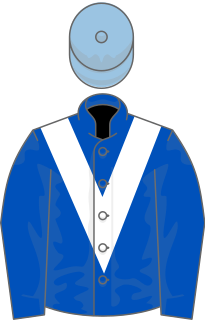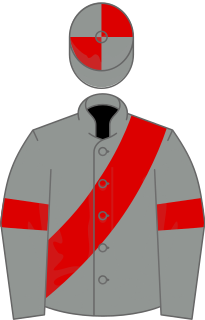Related Research Articles
Hula Dancer was an American-bred French-trained Thoroughbred racehorse.
Noblesse (1960–1972) was an Irish Thoroughbred racehorse and broodmare.
Sayyedati was a British Thoroughbred racehorse and broodmare. In a racing career which lasted from June 1992 to October 1995 she ran twenty-two times winning six races and being placed eight times. Sayyedati was one of the leading two-year-old fillies in Europe in 1992, recording Group One successes in the Moyglare Stud Stakes at the Curragh and the Cheveley Park Stakes at Newmarket Racecourse. After being beaten on her three-year-old debut, Sayyedati won the Classic 1000 Guineas. She went on to become a successful international performer over a mile, winning the Prix Jacques Le Marois at Deauville in 1993 and the Sussex Stakes at Goodwood as a five-year-old. She was also placed in several major races including the Breeders' Cup Mile. Sayyedati was retired from racing to become a broodmare at the end of her five-year-old season.
Shadayid was an American-bred, British-trained Thoroughbred racehorse and broodmare. In a racing career which lasted from June 1990 to November 1991 she ran eleven times winning five races and being placed five times. Shadayid was one of the leading two-year-old fillies in Europe in 1990, winning all three of her races including the Group One Prix Marcel Boussac at the Longchamp. After winning the Fred Darling Stakes on her three-year-old debut, Shadayid took her unbeaten run to five by winning the Classic 1000 Guineas at Newmarket. Although she never won again, she finished second in the Coronation Stakes and the Sussex Stakes and third in the Haydock Sprint Cup and the Queen Elizabeth II Stakes. Shadayid was retired from racing to become a broodmare at the end of her three-year-old season after finishing seventh in the Breeders' Cup Mile.

Salsabil was an Irish-bred, British-trained Thoroughbred racehorse and broodmare. In a racing career which lasted from September 1989 to October 1990 she ran nine times and won seven races. Salsabil was one of the leading two-year-old fillies in Europe in 1989, winning two races including the Group One Prix Marcel Boussac at the Longchamp. After winning the Fred Darling Stakes on her three-year-old debut, Salsabil won both of Britain's Classic races for fillies: the 1000 Guineas over one mile at Newmarket and the Oaks over one and a half miles at Epsom. She was then raced against colts and became the first filly for ninety years to win the Irish Derby at the Curragh. In autumn, Salsabil added a victory in the Prix Vermeille at Longchamp but finished unplaced when favourite for the Prix de l'Arc de Triomphe in October. Salsabil was then retired to stud where she had success as a broodmare before dying of cancer in 1996.

Light Shift was an American-bred, British-bred Thoroughbred racehorse and broodmare best known for winning the 2007 Epsom Oaks. In a racing career which lasted from June 2006 to October 2007 the filly ran nine times and won four races. After winning once as a two-year-old, Light Shift won the Cheshire Oaks on her second appearance as a three-year-old. She then won the Classic Oaks over one and a half miles at Epsom, beating the Irish filly Peeping Fawn. Light Shift never won another race, being beaten by Peeping Fawn in the Irish Oaks and the Nassau Stakes and finishing unplaced in the Prix de l'Opéra.

Imagine was an Irish Thoroughbred racehorse and broodmare best known for winning the Irish 1000 Guineas and The Oaks in 2001. In a racing career which lasted from August 2000 to June 2001 the filly ran ten times and won four races. As a two-year-old, Imagine ran six times, winning the Group Three C. L. Weld Park Stakes at the Curragh and finishing second in the Group Two Rockfel Stakes at Newmarket. The following spring, the filly was beaten in her first two races before winning the Irish 1000 Guineas at the Curragh. Imagine recorded her most valuable success on her final appearance, winning the Classic Oaks over one and a half miles at Epsom. She never raced again, but proved to be a successful broodmare.

Moonshell was an Irish-bred Thoroughbred racehorse and broodmare best known for winning The Oaks in 1995. In a racing career which lasted from October 1994 to May 1996, the filly ran five times and won two races. After winning her only race as a two-year-old, Moonshell joined the Godolphin Racing team and spent the winter in Dubai. In the spring of 2005, she returned to England to finish third in the 1000 Guineas at Newmarket and then won the Classic Oaks over one and a half miles at Epsom. Moonshell did not run again as a three-year-old and was well beaten in two races in 1996 before being retired to stud.
Exhibitionnist was a French-bred, British-trained Thoroughbred racehorse and broodmare, best known for winning two Classics in 1937. The filly won three times from six races in a racing career which lasted from 1936 until July 1937. After winning as a two-year-old she finished second on her three-year-old debut to Mid-day Sun, a colt who went on to win The Derby. Exhibitionnist then won the 1000 Guineas over one mile at Newmarket and at Epsom Oaks over one and a half miles at Epsom Downs Racecourse a month later. She finished fourth in her only subsequent race and was retired to stud, where she had some success as a broodmare.

Midway Lady was an American-bred, British-trained Thoroughbred racehorse and broodmare who won two British Classic Races in 1986. In a racing career lasting from August 1985 until June 1986, the filly ran six times and won her last five races. She sustained her only defeat when finishing second on her racecourse debut but won her remaining three races in 1985 including the May Hill Stakes at Doncaster and the Prix Marcel Boussac at Longchamp. Her three-year-old campaign consisted of only two races, as she won the 1000 Guineas at Newmarket and the Oaks at Epsom a month later. After sustaining a serious leg injury, she was retired to stud where she became a successful producer of winners including the Oaks winner Eswarah.
Musical Bliss (1986–2006) was an American-bred, British-trained Thoroughbred racehorse and broodmare who won the classic 1000 Guineas in 1989. In a racing career lasting from July 1988 until August 1989, the filly ran five times and won three races. In 1988, Musical Bliss won both her races including the Rockfel Stakes at Newmarket Racecourse. On her first appearance as a three-year-old, she won the 1000 Guineas but ran poorly in her two other races and was retired from racing at the end of the year. Her record as a broodmare was mixed.

Cobweb (1821–1848) was an undefeated British Thoroughbred racehorse and who won two British Classic Races as a three-year-old and went on to become a highly successful broodmare. Cobweb's racing career consisted of three competitive races in the early part of 1824. After winning on her debut she claimed a second prize when her opponents were withdrawn by their owners. She then won the 1000 Guineas at Newmarket Racecourse and the Oaks Stakes at Epsom Downs Racecourse before being retired to stud.

Nike was a British Thoroughbred racehorse. She won three of her five starts, including the Oaks Stakes in 1797. She was owned Richard Grosvenor, 1st Earl Grosvenor, and later became a broodmare, with three of her foals placing in Classic races.
Coronation was a French racehorse. In a racing career which lasted from the spring of 1948 until October 1950, she ran thirteen times and won six races. As a two-year-old she was one of the best fillies of her generation in Europe, winning the Queen Mary Stakes in England and the Prix Robert Papin in France. In the following year she dead-heated for the Poule d'Essai des Pouliches, but was beaten in both the Oaks Stakes and the Irish Oaks. In October 1949 she established her reputation as one of the best fillies to race in Europe in the 20th century when she emphatically defeated a strong international field in the Prix de l'Arc de Triomphe. Her subsequent racing career was disappointing and she was a complete failure as a broodmare.

Pilgrimage (1875–1897) was a British Thoroughbred racehorse. As a two-year-old she was only defeated once and won the Dewhurst Plate. She only raced three times as a three-year-old, winning the 2000 Guineas and 1000 Guineas, before finishing as the runner-up in the Oaks Stakes. After retiring from racing she became a successful broodmare, foaling Oaks winner Canterbury Pilgrim and Derby winner Jeddah.
Milligram was a British Thoroughbred racehorse and broodmare, best known for her win over Miesque and Sonic Lady in the 1987 Queen Elizabeth II Stakes. In a racing career which lasted from September 1986 until November 1987 she ran nine times and won four races. Apart from the Queen Elizabeth II Stakes, she won the Coronation Stakes and Waterford Crystal Mile, as well as finishing second in the Prix Marcel Boussac, 1000 Guineas and Irish 1,000 Guineas. She was the highest-rated horse in the United Kingdom over one mile in 1987. Milligram was retired at the end of her three-year-old season and had some success as a broodmare.
Commotion was a British Thoroughbred racehorse and broodmare who raced during World War II and was best known for winning the classic Oaks Stakes in 1941. After racing over sprint distances, she was stepped up in distance the substitute "New Oaks" over one and a half miles at Newmarket Racecourse. On her next appearance she won the Falmouth Stakes and was then retired from racing. She later became a very successful broodmare.
Yesterday was an Irish Thoroughbred racehorse and broodmare. She showed considerable promise as a two-year-old in 2002, winning a maiden race and being placed in the Debutante Stakes and the Rockfel Stakes before taking the Eyrefield Stakes. In the following spring she won the Irish 1000 Guineas and appeared an unlucky loser when narrowly beaten in The Oaks. She failed to win again but finished placed in the Prix Vermeille, Prix de l'Opéra and the Breeders' Cup Filly and Mare Turf.
Quarter Moon was an Irish Thoroughbred racehorse and broodmare. As a two-year-old in 2001 she showed considerable promise, taking the Group 1 Moyglare Stud Stakes on the second of her two starts. In the following year she failed to win but showed top class form to finish second in four Group 1 races: the Irish 1,000 Guineas, the Epsom Oaks, the Irish Oaks and the Nassau Stakes. After retiring from racing at the end of the year she became a successful broodmare whose foals have included the Pretty Polly Stakes winner Diamondsandrubies.
Imprudence was a French Thoroughbred racehorse and broodmare. She showed very promising form as a two-year-old in 1949 when she won two races and finished second in the Prix de la Salamandre. She reached her peak in the first half of the following year when she won the Poule d'Essai des Pouliches and the 1000 Guineas before recording an emphatic victory in the Epsom Oaks. She made little impact when competing in the United States as a four-year-old. She had some success as a broodmare.
References
- 1 2 Morris, Tony; Randall, John (1990). Horse Racing: Records, Facts, Champions (Third ed.). Guinness Publishing. ISBN 0-85112-902-1.
- 1 2 "Maniac – Family 4-c". Bloodlines.net. Retrieved 2012-08-01.
- 1 2 3 4 Mortimer, Roger; Onslow, Richard; Willett, Peter (1999). Biographical Encyclopedia of British Flat Racing. Macdonald and Jane's. ISBN 0-354-08536-0.
- ↑ "Never Too Late to recoup!". Evening Times. 28 April 1960. Retrieved 2012-08-01.
- ↑ "Never Too Late Guineas winner". Windsor Star. 29 April 1960. Retrieved 2012-08-01.
- ↑ "Oaks winner was hampered". The Age. 6 June 1960. Retrieved 2012-08-01.
- ↑ "American-owned filly captures Epsom Oaks test". St. Petersburg Times. 4 June 1960. Retrieved 2012-08-01.
- ↑ "Daughters to guarantee sire's place in history". The Age . 7 February 1984. Retrieved 2013-02-05.
- ↑ "Lovelorn pedigree". Equineline. 2012-05-08. Retrieved 2012-08-01.
- ↑ Morris, Tony; Randall, John (1999). A Century of Champions. Portway Press. ISBN 978-1-901570-15-1.
- ↑ "Never Too Late pedigree". Equineline. 2012-05-08. Retrieved 2012-08-01.